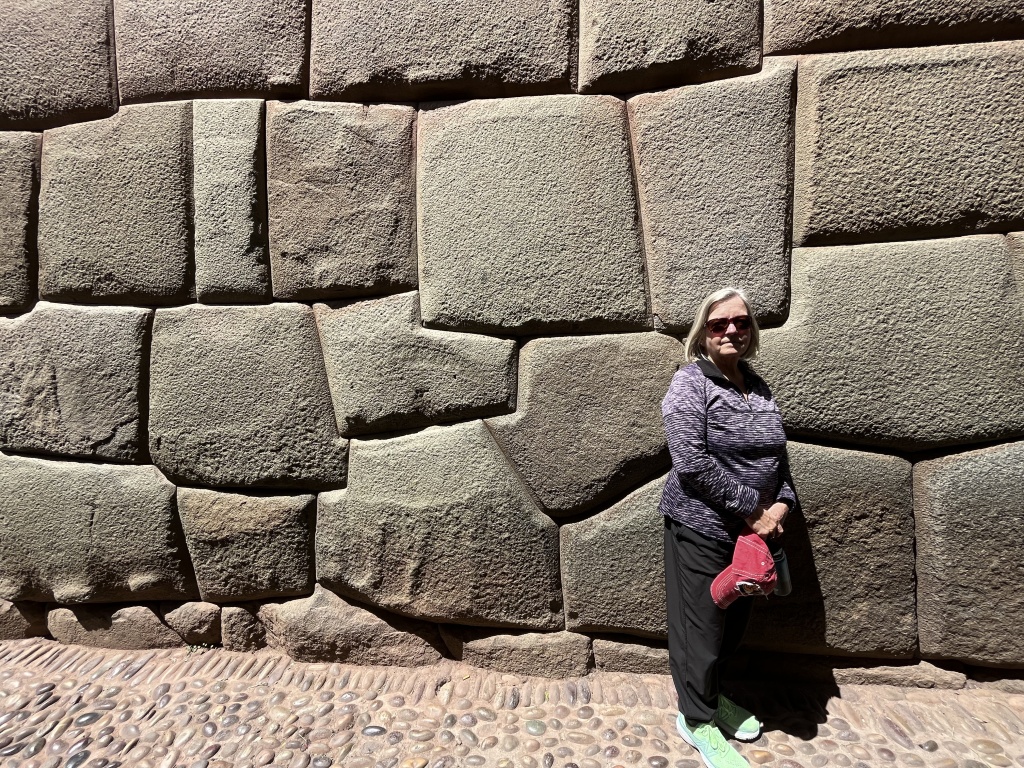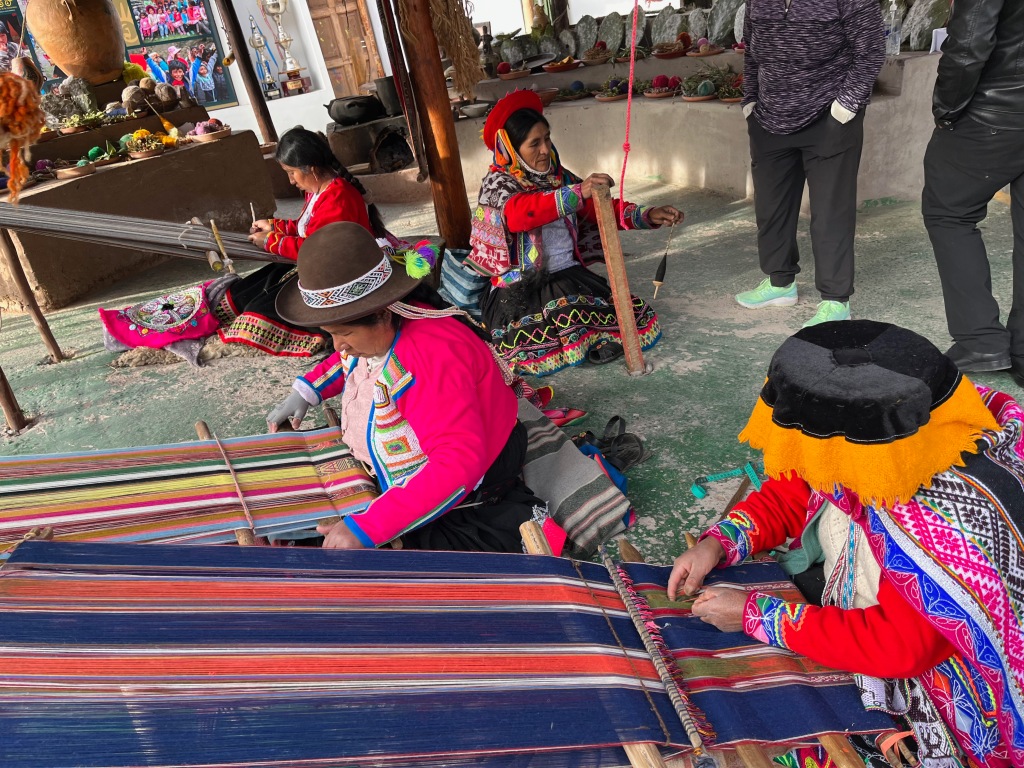This post was a hard one. I wanted to keep it relatively chronological (this is an odyssey after all, it’s what Homer would do). And I didn’t want to bore anyone with too much detail (but then again, Homer’s Odyssey is not a short fiction either). But it’s a packed day! And tomorrow promises to be even bigger, with Ruben handing us off to the Salkantay Trek leader and his team for the start of our 5 day, 4 night mountain meander.
But it’s hard for another reason. Now that I’m back home, my mind has absorbed and processed many things. And things that seemed to pass quickly and unnoticed, now come spilling out and I want to share them. So hang with me.
We had free time this morning to explore Cusco. The attendant at the Rumi Punku did a wonderful job of pointing out things to see and outlining areas that we should avoid. Cusco, after all, is over a half a million people. But there were no worries in the city center and a respectable policía presence everywhere we went. We exchanged money easily on Avenida El Sol and explored the Plaza de Armas. And we learned first-hand about the street vendors, they’re not pushy but they are relentless! “No, gracias,” became a very common phrase. We were hoping to find authentic keepsakes and there’s just no way to tell with the street vendors.

While I have several pictures of downtown Cusco and the plaza, you might get a better feel for the streets with Google Maps. I took a screenshot of the Rumi Punku entrance so you could see the double-jamb doorway, indicating a special entrance for the Inca, something I mentioned in an earlier post. So you can just click on the picture and let the Google Street View walk you down the street and look at the amazing variety of shops, restaurants, and hotels.





Sacsayhuaman – The House of the Sun
Ruben picked us up a the Rumi Punku at 1pm and we headed up above the city to Sacsayhuaman (saying “sexy woman” gets you close 🙂 ). According to Inca oral history, Pachacuti, the 9th Inca ruler, thought that Cusco, the lion city, had a body and tale, but needed a head. Sacsayhuaman, the House of the Sun, was built to complete that vision.
For the past couple of days we’ve been ‘absorbing’ the stonework remnants lining the streets of Cusco, even finding the “12 angle stone” and the puma during our walk. But these did not prepare one for the House of the Sun! As we walked closer and closer to it, it just boggled the mind. Stones, some weighing over 100 tons (two or three times a fully loaded tractor trailer in the USA), are fitted so tightly together they look watertight! There’s no mortar and the stone puzzle pieces even look playful, with crazy angles and curves.
We are used to thinking, maybe it’s because of the way we’ve been taught (history is written by the conquistadors, after all), that living in these other cultures were terrible times. That it’s only our ‘enlightened’ way of living that leads to happiness. I didn’t get that sense here. There is a pride in this construction, and it took great effort from thousands over decades to do it.
The Inca ordered that the provinces should provide 20,000 men and that the villages should send the necessary provisions. If any fell sick, another labourer was to supply his place, and he was to return to his home. But these Indians were not kept constantly at a work in progress. They laboured for a limited time, and were then relieved by others, so that they did not feel the demand on their services.
Spanish Chronicler Pedro Cieza de León, 1553 (from wikipedia)
Much of this stonework would have been covered in gold plate. Can you imagine what this place must have looked like? All we have remaining today is the foundation, really.






As I walked about, observing what was to be seen, I beheld, near the fortress, a stone which measured 260 of my palmos in circuit, and so high that it looked as if it was in its original position. All the Indians say that the stone got tired at this point, and that they were unable to move it further. Assuredly if I had not myself seen that the stone had been hewn and shaped I should not have believed, however much it might have been asserted, that the force of man would have sufficed to bring it to where it now is. There it remains, as a testimony of what manner of men those were who conceived so good a work. The Spaniards have so pillaged and ruined it, that I should be sorry to have been guilty of the fault of those in power who have permitted so magnificent a work to be so ruined.
Spanish Chronicler Pedro Cieza de León
This is like trying to photograph the Grand Canyon. You try to get an angle that expresses it and after a while you throw up you hands, sigh and say, “Oh well, they’ll just have to see it for themselves.” I didn’t do a very good job of capturing all of the “ramparts,” but I think that they represented the “teeth” of the puma’s head. The circular bases were for a tall, 3-ringed tower that set at the very top and must have dominated the landscape, especially if clad in gold!
Q’engo
Just a short drive from Sacsayhuaman is Q’engo, this one of the places where the Inca mummified the remains of their leaders and people of importance.



Puca Pucara, Tambomachay, and the Andean Rescue and Interpretation Center
From there, the van took us to Puca Pucaru, an Incan observatory, at over 12,000 feet, the night sky must be stunning.


As we walked around, Ruben showed us several things. Like the double-jamb entrance, signifying importance. Or a low place in the rock floor, that was filled with water so that the astronomers could look at the heavens reflected in the pool and not have to lay on their backs.
And there’s this, embedded in the wall. Ruben is touching the centers of two flowers, each with four large petals radiating out. Pretty cool.
In the small village of Tambomachay lies the Andean Rescue and Interpretation Center. They keep llamas and alpacas, and are registered to work with the vicuña, the smallest, the softest, and the most endangered.



The wool is taken every couple of years. And for the alpacas, the baby wool is the softest. The wool from the vicuña, is the best of the best, a sweater in the US may be $6k.The weaving is done locally, and the picture above shows the array of plants used to create the natural dyes. The white ‘frosting’ on the prickly pear is actually a fungus.

When crushed, it’s black, and when mixed with ash, it makes red. With lime, it becomes blue. Those two make purple, and all together you get brown. The owner was doing this so fast we could hardly keep up!
Needless to say, that now-empty duffle we brought is going back filled with some fine winter wear!
Q’orichancha – The Golden Temple
Our last stop of the day were the ruins of the Golden Temple, located in the navel of the world, Cusco. Of course, the Spaniards razed all they could, stealing the gold and using the smaller stones to build their houses and even a convent on top of the foundation of the Incan temple.
But some of the construction was left intact. And it’s pretty magnificent. Rather than the playful curved boulders, the stones have straight sides…but every one is unique and fitted without mortar.

So what is it with the stones anyway?
Why all the effort? Maybe simply enough…earthquakes. There are two colliding tectonic plates here, earthquakes are common. The Inca came up with a system they thought would last for all time. In fact, a major earthquake in 1650 leveled many of the newer Spanish structures without damaging the Incan works.
And yet there are more tricks up the Incan sleeve. The walls are all trapezoidal and lean into each other at about 5 degrees. The doorways and windows angle in slightly for stability.
Ah, but look at the picture. On the tops of some stones, racetracks and ‘I’ shapes were carved, matching across stones. Metal alloy was poured into these shapes to bind adjacent stones together before the next course was fitted. Phenomenal!



The Inca empire reigned over 500 years. It is estimated that there were over 12,000,000 people living in the empire before the first wave of European diseases swept through. The Spaniards arrived soon after in the 1500’s and it was all brutally destroyed. Spanish chroniclers said the stones at the House of the Sun were covered in gold plate, and that 700 were removed by Pizarro’s men.

We toured the convent now sitting on the foundation of the Golden Temple. But for some strange reason, we weren’t allowed to take photos, even without a flash.
There were many gilded paintings and enclaves holding figures from the Bible and Christian saints.
In the Cusco Cathedral, one large painting jumped out at me. Painted in 1723, it depicts the Last Supper. This is a photo I found online.
And yes, that’s a guinea pig. It’s almost as if to say, “I know we destroyed your way of life and killed your people, but we’re on the side of Christ. And you can be on his side too. See?”

It’s a lot to think about. The expansion of Europe and the conquests. The Pilgrims pushing the Indians off their land with cries of “manifest destiny.” It seems pretty obvious to me that things were WAY worse for the common man on the other side of the Atlantic. The Americas most certainly looked like Heaven on Earth. Unfortunately, the New World was just a place to continue to spread the Old World. I wonder what it would be like if the Americas had been left alone?
Well, I’m glad I got all of that out. Tonight we have to pack up our duffels with all we will need for seven days, the rest of our luggage will remain at the Rumi Punku.
Before the trek though, we have a couple more stops. And I think they will fascinate you.
The mountains are calling and we must go…



